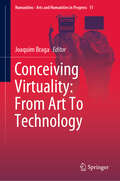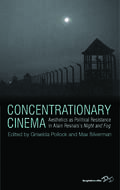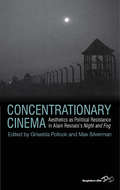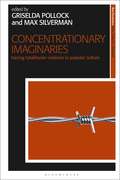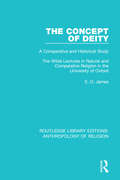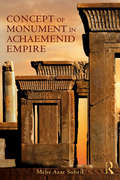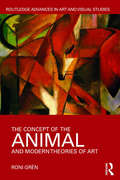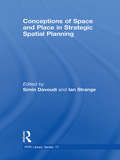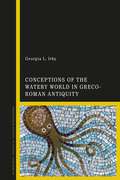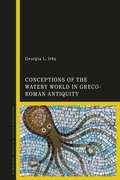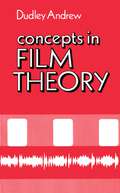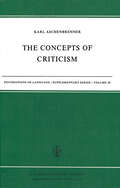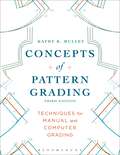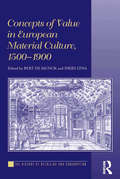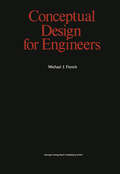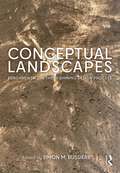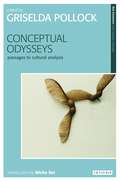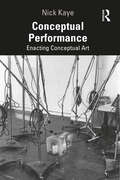- Table View
- List View
Conceiving Virtuality: From Art To Technology (Numanities - Arts and Humanities in Progress #11)
by Joaquim BragaThis book provides new theoretical approaches to the subject of virtuality. All chapters reflect the importance of extending the analysis of the concept of “the virtual” to areas of knowledge that, until today, have not been fully included in its philosophical foundations. The respective chapters share new insights on art, media, psychic systems and technology, while also presenting new ways of articulating the concept of the virtual with regard to the main premises of Western thought. Given its thematic scope, this book is intended not only for a philosophical audience, but also for all scientists who have turned to the humanities in search of answers to their questions.
Concentrationary Cinema: Aesthetics as Political Resistance in Alain Resnais's <I>Night and Fog</I>
by Griselda Pollock Max SilvermanSince its completion in 1955, Alain Resnais’s Night and Fog (Nuit et Brouillard) has been considered one of the most important films to confront the catastrophe and atrocities of the Nazi era. But was it a film about the Holocaust that failed to recognize the racist genocide? Or was the film not about the Holocaust as we know it today but a political and aesthetic response to what David Rousset, the French political prisoner from Buchenwald, identified on his return in 1945 as the ‘concentrationary universe’ which, now actualized, might release its totalitarian plague any time and anywhere? What kind of memory does the film create to warn us of the continued presence of this concentrationary universe? This international collection re-examines Resnais’s benchmark film in terms of both its political and historical context of representation of the camps and of other instances of the concentrationary in contemporary cinema. Through a range of critical readings, Concentrationary Cinema explores the cinematic aesthetics of political resistance not to the Holocaust as such but to the political novelty of absolute power represented by the concentrationary system and its assault on the human condition.
Concentrationary Cinema: Aesthetics as Political Resistance in Alain Resnais's <I>Night and Fog</I>
by Griselda Pollock Max SilvermanSince its completion in 1955, Alain Resnais’s Night and Fog (Nuit et Brouillard) has been considered one of the most important films to confront the catastrophe and atrocities of the Nazi era. But was it a film about the Holocaust that failed to recognize the racist genocide? Or was the film not about the Holocaust as we know it today but a political and aesthetic response to what David Rousset, the French political prisoner from Buchenwald, identified on his return in 1945 as the ‘concentrationary universe’ which, now actualized, might release its totalitarian plague any time and anywhere? What kind of memory does the film create to warn us of the continued presence of this concentrationary universe? This international collection re-examines Resnais’s benchmark film in terms of both its political and historical context of representation of the camps and of other instances of the concentrationary in contemporary cinema. Through a range of critical readings, Concentrationary Cinema explores the cinematic aesthetics of political resistance not to the Holocaust as such but to the political novelty of absolute power represented by the concentrationary system and its assault on the human condition.
Concentrationary Imaginaries: Tracing Totalitarian Violence in Popular Culture (New Encounters: Arts, Cultures, Concepts)
by Griselda Pollock Max SilvermanWhat defines 'quality' in contemporary Hollywood film? Although often seen as inhospitable to such work, the studios of the blockbuster-franchise era continue to produce features that make claims to higher status. Films such as The Social Network, The Assassination of Jesse James by the Coward Robert Ford and Mystic River are marked as distinctive from the mainstream norm. But how exactly, and how are such qualities mixed with more familiar Hollywood ingredients, as found in larger doses in other examples such as Blood Diamond and the blockbuster-scale Inception?Quality Hollywood is the first book to address these issues, featuring close analysis of case study films, critical responses and the wider notions of cultural value on which these draw. Geoff King argues that such films retain a presence as a minority strand of studio output. The reasons for this combine factors relating to economics, the power of certain filmmakers and Hollywood's investment in its own prestige.
The Concept of Deity: A Comparative and Historical Study. The Wilde Lectures in Natural and Comparative Religion in the University of Oxford (Routledge Library Editions: Anthropology of Religion #2)
by E.O. JamesFor good or ill, most, if not all, of the great institutions which have formed the framework of society have had their roots in the idea of Deity as a beneficent providential order of transcendental reality. In being handed down through countless generations the beliefs, concepts and customs have assumed a great variety of new outward forms in the process of transmission and development. To determine their true meaning and function as a cohesive force and as an expression of ultimate reality, the comparative and historical methods can be employed with considerable advantage. This book, first published in 1950, provides a valuable comparative study of religion.
The Concept of Deity: A Comparative and Historical Study. The Wilde Lectures in Natural and Comparative Religion in the University of Oxford (Routledge Library Editions: Anthropology of Religion #2)
by E.O. JamesFor good or ill, most, if not all, of the great institutions which have formed the framework of society have had their roots in the idea of Deity as a beneficent providential order of transcendental reality. In being handed down through countless generations the beliefs, concepts and customs have assumed a great variety of new outward forms in the process of transmission and development. To determine their true meaning and function as a cohesive force and as an expression of ultimate reality, the comparative and historical methods can be employed with considerable advantage. This book, first published in 1950, provides a valuable comparative study of religion.
The Concept of Monument in Achaemenid Empire
by Mehr Azar SoheilThe aim of this book is to explore the significance of the concept of ‘monument’ in the context of the Achaemenid Empire (550-330 BC), with particular reference to the Royal Ensemble of Persepolis, founded by Darius I and built together with his son Xerxes. While Persepolis was built as an ‘intentional monument’, it had already become an ‘historic monument’ during the Achaemenid period. It maintained its symbolic significance in the following centuries even after its destruction by Alexander of Macedonia in 330 BC. The purpose of building Persepolis was to establish a symbol and a common reference for the peoples of the Empire with the Achaemenid Dynasty, transmitting significant messages and values such as peace, stability, grandeur and praise for the dynastic figure of the king as the protector of values and fighting falsehood. While previous research on Achaemenid heritage has mainly been on archaeological and art-historical aspects of Persepolis, the present work focuses on the architecture and design of Persepolis. It is supported by studies in the fields of archaeology, history and art history, as well as by direct survey of the site. The morphological analysis of Persepolis, including the study of the proportions of the elevations, and the verification of a planning grid for the layout of the entire ensemble demonstrate the univocal will by Darius to plan Persepolis following a precise initial scheme. The study shows how the inscriptions, bas-reliefs and the innovative architectural language together express the symbolism, values and political messages of the Achaemenid Dynasty, exhibiting influence from different lands in a new architectural language and in the plan of the entire site.
The Concept of Monument in Achaemenid Empire
by Mehr Azar SoheilThe aim of this book is to explore the significance of the concept of ‘monument’ in the context of the Achaemenid Empire (550-330 BC), with particular reference to the Royal Ensemble of Persepolis, founded by Darius I and built together with his son Xerxes. While Persepolis was built as an ‘intentional monument’, it had already become an ‘historic monument’ during the Achaemenid period. It maintained its symbolic significance in the following centuries even after its destruction by Alexander of Macedonia in 330 BC. The purpose of building Persepolis was to establish a symbol and a common reference for the peoples of the Empire with the Achaemenid Dynasty, transmitting significant messages and values such as peace, stability, grandeur and praise for the dynastic figure of the king as the protector of values and fighting falsehood. While previous research on Achaemenid heritage has mainly been on archaeological and art-historical aspects of Persepolis, the present work focuses on the architecture and design of Persepolis. It is supported by studies in the fields of archaeology, history and art history, as well as by direct survey of the site. The morphological analysis of Persepolis, including the study of the proportions of the elevations, and the verification of a planning grid for the layout of the entire ensemble demonstrate the univocal will by Darius to plan Persepolis following a precise initial scheme. The study shows how the inscriptions, bas-reliefs and the innovative architectural language together express the symbolism, values and political messages of the Achaemenid Dynasty, exhibiting influence from different lands in a new architectural language and in the plan of the entire site.
The Concept of the Animal and Modern Theories of Art (Routledge Advances in Art and Visual Studies)
by Roni GrénThis book examines the importance of the animal in modern art theory, using classic texts of modern aesthetics and texts written by modern artists to explore the influence of the human-animal relationship on nineteenth and twentieth century artists and art theorists. The book is unique due to its focus on the concept of the animal, rather than on images of animals, and it aims towards a theoretical account of the connections between the notions of art and animality in the modern age. Roni Grén’s book spans various disciplines, such as art theory, art history, animal studies, modernism, postmodernism, posthumanism, philosophy, and aesthetics.
The Concept of the Animal and Modern Theories of Art (Routledge Advances in Art and Visual Studies)
by Roni GrénThis book examines the importance of the animal in modern art theory, using classic texts of modern aesthetics and texts written by modern artists to explore the influence of the human-animal relationship on nineteenth and twentieth century artists and art theorists. The book is unique due to its focus on the concept of the animal, rather than on images of animals, and it aims towards a theoretical account of the connections between the notions of art and animality in the modern age. Roni Grén’s book spans various disciplines, such as art theory, art history, animal studies, modernism, postmodernism, posthumanism, philosophy, and aesthetics.
Conceptions of Space and Place in Strategic Spatial Planning (RTPI Library Series)
by Simin Davoudi Ian StrangeBringing together authors from academia and practice, this book examines spatial planning at different places throughout the British Isles. Six illustrative case studies of practice examine which conceptions of space and place have been articulated, presented and visualized through the production of spatial strategies. Ranging from a large conurbation (London) to regional (Yorkshire and Humber) and national levels, the case studies give a rounded and grounded view of the physical results and the theory behind them. While there is widespread support for re-orienting planning towards space and place, there has been little common understanding about what constitutes ‘spatial planning’, and what conceptions of space and place underpin it. This book addresses these questions and stimulates debate and critical thinking about space and place among academic and professional planners.
Conceptions of Space and Place in Strategic Spatial Planning (RTPI Library Series)
by Simin Davoudi Ian StrangeBringing together authors from academia and practice, this book examines spatial planning at different places throughout the British Isles. Six illustrative case studies of practice examine which conceptions of space and place have been articulated, presented and visualized through the production of spatial strategies. Ranging from a large conurbation (London) to regional (Yorkshire and Humber) and national levels, the case studies give a rounded and grounded view of the physical results and the theory behind them. While there is widespread support for re-orienting planning towards space and place, there has been little common understanding about what constitutes ‘spatial planning’, and what conceptions of space and place underpin it. This book addresses these questions and stimulates debate and critical thinking about space and place among academic and professional planners.
Conceptions of the Watery World in Greco-Roman Antiquity
by Georgia L. IrbyThis book explores ancient efforts to explain the scientific, philosophical, and spiritual aspects of water. From the ancient point of view, we investigate many questions including: How does water help shape the world? What is the nature of the ocean? What causes watery weather, including superstorms and snow? How does water affect health, as a vector of disease or of healing? What is the nature of deep-sea-creatures (including sea monsters)? What spiritual forces can protect those who must travel on water? This first complete study of water in the ancient imagination makes a major contribution to classics, geography, hydrology and the history of science alike.Water is an essential resource that affects every aspect of human life, and its metamorphic properties gave license to the ancient imagination to perceive watery phenomena as the product of visible and invisible forces. As such, it was a source of great curiosity for the Greeks and Romans who sought to control the natural world by understanding it, and who, despite technological limitations, asked interesting questions about the origins and characteristics of water and its influences on land, weather, and living creatures, both real and imagined.
Conceptions of the Watery World in Greco-Roman Antiquity
by Georgia L. IrbyThis book explores ancient efforts to explain the scientific, philosophical, and spiritual aspects of water. From the ancient point of view, we investigate many questions including: How does water help shape the world? What is the nature of the ocean? What causes watery weather, including superstorms and snow? How does water affect health, as a vector of disease or of healing? What is the nature of deep-sea-creatures (including sea monsters)? What spiritual forces can protect those who must travel on water? This first complete study of water in the ancient imagination makes a major contribution to classics, geography, hydrology and the history of science alike.Water is an essential resource that affects every aspect of human life, and its metamorphic properties gave license to the ancient imagination to perceive watery phenomena as the product of visible and invisible forces. As such, it was a source of great curiosity for the Greeks and Romans who sought to control the natural world by understanding it, and who, despite technological limitations, asked interesting questions about the origins and characteristics of water and its influences on land, weather, and living creatures, both real and imagined.
Concepts in Film Theory
by J. Dudley AndrewConcepts in Film Theory is a continuation of Dudley Andrew's classic, The Major Film Theories. In writing now about contemporary theory, Andrew focuses on the key concepts in film study -- perception, representation, signification, narrative structure, adaptation, evaluation, identification, figuration, and interpretation. Beginning with an introductory chapter on the current state of film theory, Andrew goes on to build an overall view of film, presenting his own ideas on each concept, and giving a sense of the interdependence of these concepts. Andrew provides lucid explanations of theories which involve perceptual psychology and structuralism; semiotics and psychoanalysis; hermeneutics and genre study. His clear approach to these often obscure theories enables students to acquire the background they need to enrich their understanding of film -- and of art.
The Concepts of Criticism (Foundations of Language Supplementary Series #20)
by L. AschenbrennerTbis inquiry may be thought of as a sequel to The Concepts of Value and as an extension of the brief core-vocabulary of aesthetic concepts found in one of the appendices to it. In terms of sheer numbers, most of the value concepts of our language are to be found in the area of human relations and of the aesthetic. There are also other value vocabularies, shorter but equally important, for example, the cognitive and logical. These and other objects of pbilosopbical study (for example, the question of "other minds") deserve the kind of empirical survey that has been made of moral and aesthetic notions, if only to test a priori approaches to them. In the present studyan even more determined empirical approach than that adopted for the first has been found necessary. Once the moral or human value vocabulary has been identified, sentential contexts for the use of the terms readily come to mind. In a study of the language of criticism, however, the vocabulary has first to be sought in the utterances of critics themselves and quoted in sufficient context to make their critical intentions clear. The outcome is that the present study is of great length, about half of it being quotations from critics. The rule adopted for arriving at tbis length go on collecting quotations as long as new types of appraisal came was to to light.
Concepts of Pattern Grading: Techniques for Manual and Computer Grading - with STUDIO
by Kathy K. MulletThis step-by-step introduction to grading combines the theory of pattern grading with its practical applications. After presenting the x, y orientation to familiarize readers with the concepts of computer grading and using the Cartesian graph, the text takes a holistic approach, integrating anthropometry, size specifications, and grade guides into the grading process for women's garments with emphasis on maintaining fit and style sense. New to this Edition: - Expanded discussion of computer grading technology including Optitex, Gerber, Lectra, and Tukatech software- 20% new end-of-chapter exercises- Includes more than 200 illustrations and 85 tables for grade rules, measurement charts and garment specifications- Added discussion on grading from specifications and development of tolerances- Instructor's Guide and Test Bank provide answers to exercises, completed and blank grade rule tables, grade charts for different base sizes and projects for further researchConcepts of Pattern Grading STUDIO:- Study smarter with self-quizzes featuring scored results and personalized study tips- Review concepts with flashcards of terms and definitions- Practice your skills with extra exercisesPLEASE NOTE: Purchasing or renting this ISBN does not include access to the STUDIO resources that accompany this text. To receive free access to the STUDIO content with new copies of this book, please refer to the book + STUDIO access card bundle ISBN 9781501312823. STUDIO Instant Access can also be purchased or rented separately on BloomsburyFashionCentral.com.
Concepts of Value in European Material Culture, 1500-1900 (The History of Retailing and Consumption)
by Bert De Munck Dries LynaIn contemporary society it would seem self-evident that people allow the market to determine the values of products and services. For everything from a loaf of bread to a work of art to a simple haircut, value is expressed in monetary terms and seen as determined primarily by the 'objective' interplay between supply and demand. Yet this 'price-mechanism' is itself embedded in conventions and frames of reference which differed according to time, place and product type. Moreover, the dominance of the conventions of utility maximising and calculative homo economicus is a relatively new phenomenon, and one which directly correlates to the steady advent of capitalism in early modern Europe. This volume brings together scholars with expertise in a variety of related fields, including economic history, the history of consumption and material culture, art history, and the history of collecting, to explore changing concepts of value from the early modern period to the nineteenth century and present a new view on the advent of modern economic practices. Jointly, they fundamentally challenge traditional historical narratives about the rise of our contemporary market economy and consumer society.
Concepts of Value in European Material Culture, 1500-1900 (The History of Retailing and Consumption)
by Bert De Munck Dries LynaIn contemporary society it would seem self-evident that people allow the market to determine the values of products and services. For everything from a loaf of bread to a work of art to a simple haircut, value is expressed in monetary terms and seen as determined primarily by the 'objective' interplay between supply and demand. Yet this 'price-mechanism' is itself embedded in conventions and frames of reference which differed according to time, place and product type. Moreover, the dominance of the conventions of utility maximising and calculative homo economicus is a relatively new phenomenon, and one which directly correlates to the steady advent of capitalism in early modern Europe. This volume brings together scholars with expertise in a variety of related fields, including economic history, the history of consumption and material culture, art history, and the history of collecting, to explore changing concepts of value from the early modern period to the nineteenth century and present a new view on the advent of modern economic practices. Jointly, they fundamentally challenge traditional historical narratives about the rise of our contemporary market economy and consumer society.
Conceptual Design for Engineers
by Michael J. French3. 2 Making capital and running costs commensurate 49 3. 3 Optimum speed of a tanker 50 3. 4 The optimisation of the sag:span ratio of a suspension bridge 52 3. 5 Optimisation with more than one degree of freedom: heat exchanger 55 3. 6 Putting a price on heat-exchanger performance 57 3. 7 Variation of costs with application 59 3. 8 Further aspects of heat-exchanger optimisation 59 3. 9 An elementary programming problem 60 3. 10 Classification of optimisation problems and methods of solution 62 3. 11 The design of rotating discs: an optimum structure 66 3. 12 Hubdesign 73 3. 13 Summary 73 Questions 73 Answers 74 4 Insight 4. 1 Introduction 76 4. 2 Rough calculations 76 4. 3 Optimisation of compressor shaft diameter 83 4. 4 The optimum virtual shaft: a digression 85 4. 5 Useful measures and concepts 87 4. 6 Bounds and limits 91 4. 7 Scale effects 94 4. 8 Dimensional analysis and scaling 98 4. 9 Proportion 99 100 4. 10 Change of viewpoint Questions 102 104 Answers 5 Matching 5. 1 Matching: the windlass 107 5. 2 An extended example of matching: ship propulsion 107 5. 3 Matching within a single machine III 5. 4 Further aspects of ship propulsion 112 5. 5 Specific speeds: degrees of freedom 113 5. 6 Matching of a spring to its task liS 5. 7 Matching in thermodynamic processes 117 5. 8 Two old cases of matching 121 5.
Conceptual Landscapes: Fundamentals in the Beginning Design Process
by Simon M. BussiereConceptual Landscapes explores the dilemma faced in the early moments of design thinking through a gradient of work in landscape and environmental design media by both emerging and well-established designers and educators of landscape architecture. It questions where and, more importantly, how the process of design starts. The book deconstructs the steps of conceptualizing design in order to reignite pedagogical discussions about timing and design fundamentals, and to reveal how the spark of an idea happens – from a range of unique perspectives. Through a careful arrangement of visual essays that integrate analog, digital, and mixed-media works and processes, the book highlights differences between diverse techniques and triggers debate between design, representation, technology, and creative culture in the field. Taken together, the book’s visual investigation of the conceptual design process serves as a learning tool for aspiring designers and seasoned professionals alike. By situating student work alongside that of experienced teachers and landscape architects, the book also demystifies outdated notions of individual genius and sheds new light on the nearly universally messy process of discovery, bridged across years and diverse creative vocabularies in the conceptual design process. Lavishly illustrated with over 210 full color images, this book is a must-read for students and instructors in landscape architecture.
Conceptual Landscapes: Fundamentals in the Beginning Design Process
Conceptual Landscapes explores the dilemma faced in the early moments of design thinking through a gradient of work in landscape and environmental design media by both emerging and well-established designers and educators of landscape architecture. It questions where and, more importantly, how the process of design starts. The book deconstructs the steps of conceptualizing design in order to reignite pedagogical discussions about timing and design fundamentals, and to reveal how the spark of an idea happens – from a range of unique perspectives. Through a careful arrangement of visual essays that integrate analog, digital, and mixed-media works and processes, the book highlights differences between diverse techniques and triggers debate between design, representation, technology, and creative culture in the field. Taken together, the book’s visual investigation of the conceptual design process serves as a learning tool for aspiring designers and seasoned professionals alike. By situating student work alongside that of experienced teachers and landscape architects, the book also demystifies outdated notions of individual genius and sheds new light on the nearly universally messy process of discovery, bridged across years and diverse creative vocabularies in the conceptual design process. Lavishly illustrated with over 210 full color images, this book is a must-read for students and instructors in landscape architecture.
Conceptual Odysseys: Passages to Cultural Analysis (New Encounters: Arts, Cultures, Concepts)
by Griselda PollockThe 'theoretical turn' within the arts and humanities in the 1970s and 1980s has, for many, had its day, with work produced under its rubric all too often feeling tired or even downright lazy. In its place - whilst hazarding against an outright rejection of theory - this book, introduced by Mieke Bal, presents work by a new generation of scholars responding directly to Bal's idea of the 'travelling concept'. By taking a concept from one discipline and, with a genuine understanding of its origin, thoughtfully applying this in a new context, exciting new possibilities are opened up for analysis of artworks and other cultural objects. Here we find these 'travelling concepts' employed in fresh explorations of subjects as diverse as the paintings of Poussin and of Adam Elsheimer; Chantal Akerman's film; the Museum of the French Revolution and the work of German Jewish painter Charlotte Salomon. This is a uniquely illuminating contribution to the edgy territorial conflicts between visual culture, art history and cultural studies.
Conceptual Performance: Enacting Conceptual Art
by Nick KayeConceptual Performance explores how the radical visual art that challenged material aesthetics in the 1960s and 1970s tested and extended the limits, character and concept of performance. Conceptual Performance sets out the history, theoretical basis, and character of this genre of work through a wide range of case studies. The volume considers how and why principal modes and agendas in Conceptual art in the 1960s and 1970s necessitated new engagements with performance, as well as expanded notions of theatricality. In doing so, this book reviews and challenges prevailing histories of Conceptual art through critical frameworks of performativity and performance. It also considers how Conceptual art adopted and redefined terms and tropes of theatre and performance: including score, document, embodiment, documentation, relic, remains, and the narrative recuperation of ephemeral work. While showing how performance has been integral to Conceptual art’s critiques of prevailing assumptions about art’s form, purpose, and meaning, this volume also considers the reach and influence of Conceptual performance into recent thinking and practice. This book will be of interest to scholars and students of theatre, performance, contemporary art, and art history.
Conceptual Performance: Enacting Conceptual Art
by Nick KayeConceptual Performance explores how the radical visual art that challenged material aesthetics in the 1960s and 1970s tested and extended the limits, character and concept of performance. Conceptual Performance sets out the history, theoretical basis, and character of this genre of work through a wide range of case studies. The volume considers how and why principal modes and agendas in Conceptual art in the 1960s and 1970s necessitated new engagements with performance, as well as expanded notions of theatricality. In doing so, this book reviews and challenges prevailing histories of Conceptual art through critical frameworks of performativity and performance. It also considers how Conceptual art adopted and redefined terms and tropes of theatre and performance: including score, document, embodiment, documentation, relic, remains, and the narrative recuperation of ephemeral work. While showing how performance has been integral to Conceptual art’s critiques of prevailing assumptions about art’s form, purpose, and meaning, this volume also considers the reach and influence of Conceptual performance into recent thinking and practice. This book will be of interest to scholars and students of theatre, performance, contemporary art, and art history.
